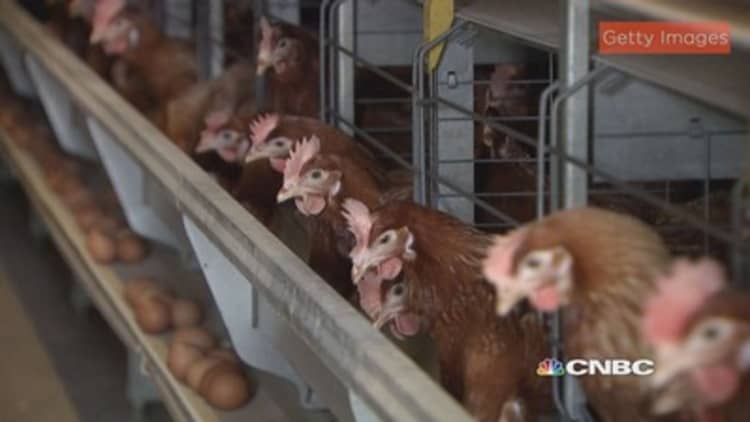
Avian flu is threatening flocks in poultry states such as Wisconsin and Iowa, and officials there are taking measures to prevent the disease from spreading.
About 8 million birds have reportedly been infected since mid-December. But experts note that the strain poses little threat to humans so far, unlike strains that sickened people in previous outbreaks.
There are many varieties of the avian flu, which is part of a larger group of influenza viruses. Some strains of avian flu cause only mild symptoms in birds, others are far more serious. The similarly known H5N1 variety has infected people, but while the H5N2 virus now in Iowa and Wisconsin is "highly pathogenic" (i.e., deadly) to birds, it poses only a low health risk to humans.
Read More
That does not mean health officials won't be watching it, said Keith Poulsen, a veterinary scientist at the University of Wisconsin. Influenza viruses are "dynamic," he said, and can spread from one species to another quickly if they mutate. But there have been no such cases reported so far.
People also cannot get the disease if they properly handle poultry products, health authorities say.
So far, the disease poses a greater risk to the poultry industry, especially exports, Poulsen said. Once it hits, the disease moves quickly through even the largest flocks.
"Some of the turkey flocks had 98 percent mortality within 48 hours, so when you are talking about 15,000 birds, so to have 15,000 birds drop dead in a day or two is quite impressive," Poulsen said.
Read MoreOklahoma: From two 3.0 quakes a year—to two a day
He noted that many of the turkeys that have been hit were breeding stock, so the outbreak could affect turkey stocks further in another year or two.
"Whether we can export that food, whether turkey, chicken or eggs, is huge because a huge proportion of agricultural profits are tied to export to other countries, and other countries don't want to import this disease," he said.
The outbreaks are following an atypical path—random and unpredictable, Poulsen said. Outbreaks often spread in concentric circles, but these are jumping great distances, leaving farms in between untouched.
Read MoreMeasles vaccine: No link to autism
One explanation is that the feathers of diseased, migrating wild birds are falling into ventilation systems or somehow getting into facilities. Even the virus' rapid arrival in North America suggests it may have been carried by wild birds.
"What is interesting about this strain is that it took years for H5N1 to migrate from Asia to North America, and this particular strain has only taken about six months, so it is moving quite a bit faster."
The types of farms hardest hit by outbreaks are also puzzling—most of them are high "biosecurity" facilities, where birds are kept in enclosed, strictly monitored environments. Workers at some of these farms are even required to shower before and after their shifts.
Read MoreNo. 1 reason solar energy's boom is just starting
Farmers were relying on that high degree of biosecurity to protect their flocks when they knew the disease was migrating toward them from the West Coast in January, Poulsen said.
"But it is obviously not working," he said. "What is frustrating is that these companies are spending a lot of money to maintain this biosecurity, and they are still paying in terms of animal mortality and lost product."
Once it's determined that farms are free of the disease, they can resume selling their product.
Scientists are expecting cases to taper off as summer approaches, and possibly increase again with the annual fall migrations of wild bird species. The cycle will likely go on for months or even years at varying levels, but we are not facing a public health crisis, Poulsen said.
"When flu comes around, people have a tendency to panic, and we don't want people to panic," he said. "There have been no cases seen in humans. We have very distinct protocols designed to handle this, and this is not the first time this has happened."


